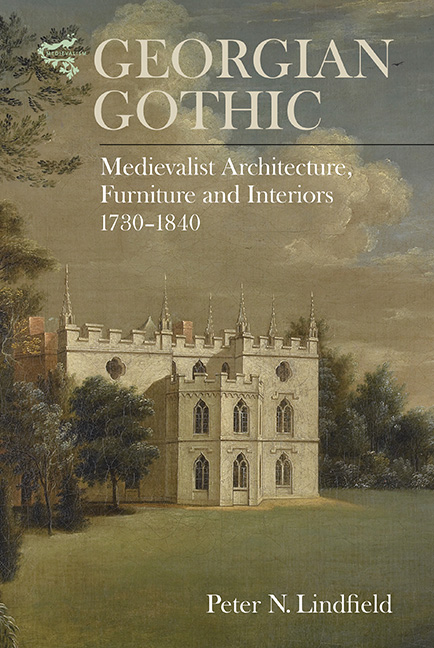Book contents
- Frontmatter
- Dedication
- Miscellaneous Frontmatter
- Contents
- List of Illustrations
- Acknowledgements
- Introduction: the Gothic Aesthetic in Britain and British Furniture, 1730–1840
- 1. Understanding Gothic Architecture in Georgian Britain
- 2. Creation of Classical Gothic Architecture, Furniture and Interiors
- 3. High Fashion and Fragments of the Past: the Omnipresence of Rococo Gothic
- 4. Fluctuating Tastes: Gothic in Later Eighteenth-century Britain
- 5. The ‘Chaos of Modern Gothic Excrescences’: Regency to Revolution
- Conclusion
- Appendix
- Bibliography
- Glossary
- Index
- Miscellaneous Endmatter
2. - Creation of Classical Gothic Architecture, Furniture and Interiors
Published online by Cambridge University Press: 25 October 2017
- Frontmatter
- Dedication
- Miscellaneous Frontmatter
- Contents
- List of Illustrations
- Acknowledgements
- Introduction: the Gothic Aesthetic in Britain and British Furniture, 1730–1840
- 1. Understanding Gothic Architecture in Georgian Britain
- 2. Creation of Classical Gothic Architecture, Furniture and Interiors
- 3. High Fashion and Fragments of the Past: the Omnipresence of Rococo Gothic
- 4. Fluctuating Tastes: Gothic in Later Eighteenth-century Britain
- 5. The ‘Chaos of Modern Gothic Excrescences’: Regency to Revolution
- Conclusion
- Appendix
- Bibliography
- Glossary
- Index
- Miscellaneous Endmatter
Summary
Gothic architecture has had its vicissitudes in this country. There was a time when its principles were universally recognised; there was a time when they were neglected or forgotten. But in the days of its lowest degradation, it may be questioned whether it would not have been better that the cause should have remained unexposed than have been sustained by such a champion as Batty Langley.
(Charles Locke Eastlake, 1872)THIS DAMNING CRITICISM of early Georgian Gothic design as manifested in the plates included in Batty Langley's pattern-book, Ancient Architecture (1741–42), comes from the first retrospective publication concerned with the medieval style's revival. The appraisal, above, by Charles Locke Eastlake (1833–1906) was conditioned by the later nineteenth century's sophisticated interpretation of medieval architecture. This critical assessment of the Gothic Revival, however, did not develop in the nineteenth century. Richard Neve in 1736, for instance, condemned what he thought to be the degradation of medieval architecture by coining the phrase ‘Modern Gothick’: ‘the Modern Gothick runs into the contrary Extreme, and is known by its Disposition, and by its affected Lightness, Delicacy, and over-rich, and even whimsical Decorations’ almost thirty years later, Horace Walpole (1717–97), one of the eighteenth century's most prolific supporters of medieval design, laid the blame for the abomination that was ‘bastard Gothic’ squarely at the door of Batty Langley:
all that his books achieved, has been to teach carpenters to massacre that venerable species [of architecture, and] has given occasion to those who know nothing of the matter, and who mistake his clumsy efforts for real imitations, to censure the productions of our ancestors, whose bold and beautiful fabrics sir Christopher Wren viewed and reviewed with astonishment, and never mentioned without esteem.
It is easy to appreciate these criticisms, particularly given that we live now in an age of architectural awareness in which archaeological and historical accuracy matter to the understanding of past creations and architectural styles. To our educated eye, as for Eastlake's, eighteenth-century Gothic is most certainly not medieval in form, style and ethos. It is, nonetheless, inspired by medieval structures, and apes their visual language. But to sideline this reinterpretation of medieval design as an infantile and meritless precursor to the ‘proper’ Gothic Revival of the nineteenth century is to ignore its value, importance, influence and place in the history of eighteenth- century taste.
- Type
- Chapter
- Information
- Georgian GothicMedievalist Architecture, Furniture and Interiors, 1730-1840, pp. 42 - 80Publisher: Boydell & BrewerPrint publication year: 2016



